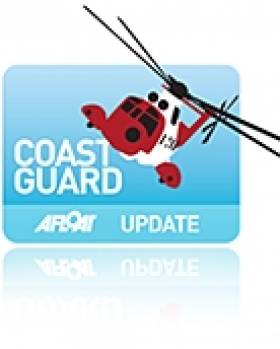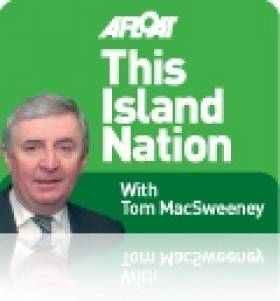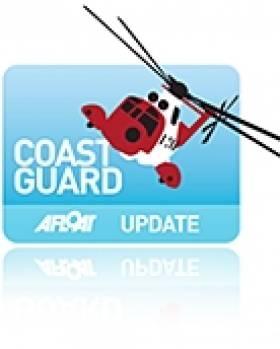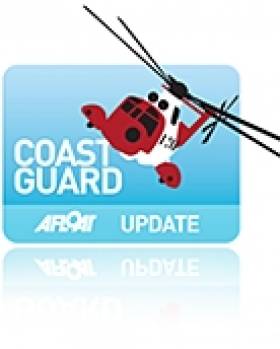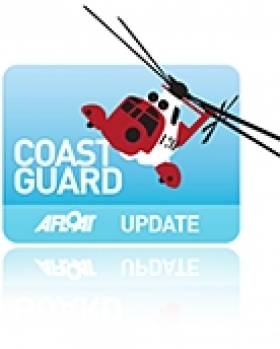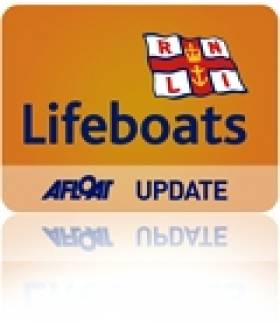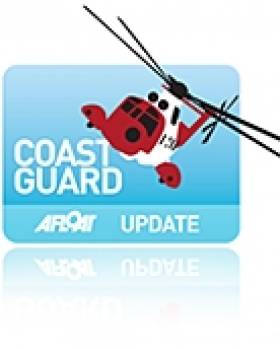Displaying items by tag: Coastguard
Man and Child Drowned Off West Cork
#News - TheJournal.ie is reporting news of the tragic drowning of a man and a young child off West Cork in the early hours of this morning (6 March).
The bodies of the man and the three-year-old girl were recovered by emergency teams after the Goleen unit of the Irish Coast Guard was tasked to the area following a missing person's report.
Coastguard volunteers found the child on the beach but attempts to resuscitate her were unsuccessful. The body of the man was later discovered in the shallows by the Baltimore RNLI lifeboat.
It's being suspected that the man and the young child entered the water.
TheJournal.ie has more on the story HERE.
UK Coastguard Agency Head Meets Fishermen's Mission in NI
#Coastguard - The chief executive of the UK's Maritime and Coastguard Agency (MCA) was in Northern Ireland yesterday (4 March) to discuss future collaboration with the Royal National Mission to Deep Sea Fishermen.
As Fishupdate.com reports, the charity - also known as the Fishermen's Mission - provides emergency support to fishermen and their families in times of need.
Sir Alan Massey of the MCA was in Kilkeel, Co Down to meet with the charity's CEO David Dickens to find out how best to work together on their common ground of safety at sea.
"We want to encourage a culture where it becomes normal practice for all fishermen to wear a lifejacket or personal flotation device (PFD) when out at sea," said Massey.
Dickens added that the Fishermen's Mission is "keen to engage with all agencies and organisations that seek to reduce the number and severity of incidents in fishing".
#coastguard – The Chief Executive of the Maritime and Coastguard Agency (MCA), Sir Alan Massey, is today (Friday 1 March) in Northern Ireland meeting with the Royal National Mission to Deep Sea Fishermen.
Sir Alan is meeting David Dickens, Chief Executive of the charity, in Kilkeel to discuss how best to work together in future.
The Fisherman's Mission, as it is known, is one of many organisations with whom the MCA regularly liaises. The charity provides emergency support and practical care to fishermen and their families, and has a close interest in safety and welfare within the fishing industry.
Sir Alan Massey said:
"Working together with the Fishing Industry Safety Group (FISG), we are all keen to nurture improvements in the safety of commercial fishing vessel operations".
"In particular, we want to encourage a culture where it becomes normal practice for all fishermen to wear a lifejacket or personal flotation device (PFD) when out at sea. The Mission's excellent and unstinting work in support of fishermen and their families is integral to our collective efforts."
David Dickens, Chief Executive of The Fishermen's Mission, said:
"All too often The Mission staff has to deal with the devastating aftermath of death or serious injury of fishermen at sea. The Mission is keen to engage with all agencies and organisations that seek to reduce the number and severity of incidents in fishing and a positive engagement with the MCA is both natural and essential in bringing the safety message to all involved in the industry."
Searching for Trawlers, Sailing Solo, Salp & Parking Your Boat
Fishing – THE MAN WHO SEARCHED FOR 60-FOOTERS
#islandnation – Can you imagine spending years searching for old 60-foot boats, travelling the country's coastline because of a 'bug' within your system?
Pat Nolan from Cork, who now lives in County Antrim, has done that, "a labour of love, meeting with many wonderful people" who sailed these iconic vessels.
Six years ago he began tracing the histories of all eighty-eight 50-foot fishing boats built by the State fisheries board, Bord Iascaigh Mhara between 1949 and 1970, a mammoth task which he completed in two years and published in a book called 'Sea Change'. Now he has six books about fishing boats to his credit, the latest called 'A Step Up' and which, logically enough perhaps, is a record of the BIM 56-footers which were regarded as a 'step up' when introduced to Irish waters for commercial fishing.
Understandably, Pat comes from a family steeped in commercial fishing activities, into which he was born in Baltimore in West Cork. A science graduate of University College, Cork, he worked in Nigeria for a number of years before returning to Ireland and settling in Ballycastle.
He has compiled individually-traced histories of all 39 BIM-built 56-footers, a huge contribution to the archive of Ireland's maritime history. Built at several boatyards around the coast, their construction provided great employment and underwrote the shipwright tradition in Ireland which has now, unfortunately, declined to the great loss of the marine industry. Tyrrells of Arklow designed their own 56-footers for BIM.
"That all 56-footers were not identical is beyond dispute, differences existed in detail, layout and even design, but the boats were readily recognisable, regardless of variations," says Pat. "All of the boats were well-built, efficient and regarded as 'small big boats' and first-class weather boats. Yet I'd have to say there are divided opinions as to how well they met the requirements of their era, even though they were iconic boats."
Safety – ALONE ON THE WATER
My report last week that the Coast Guard had tried to get the Marine Casualty Investigation Board to make a strong recommendation against going out on the water alone drew quite a reaction from readers, varying from "nannyism" to "why can't there be mandatory licences for boating."
"What does the Coast Guard know about single-handed sailing or good seamanship for that matter? It's the same as the priests giving marriage guidance courses," Emailed Gerry Burns.
Trudy McIntyre commented: "For driving a car you need a licence and mandatory driving classes, before you go at it alone!! Why can't there be the same for pleasure boating?"
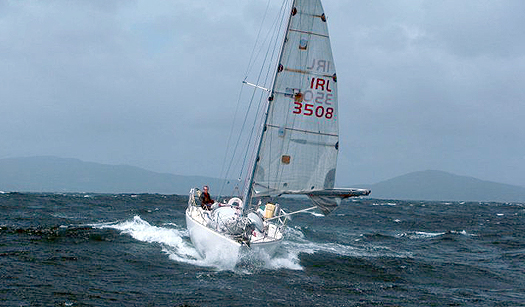
Barry Hurley sailing to solo success in Dinah
Rory described the call as: "More dictatorship and nannyism!" while Tony O'Leary wrote that "the RNLI and Coast Guard are volunteers who at the end of the day are only trying to help people when they are in trouble. In most Lifeboat and Coast Guard crews there are people who have a vast amount of experience at sea" and Jerome Lordan wrote: "Lifeboat crews and Coastguards today do not for the most part have long-time experience at sea like they had in the past when these units were manned by experienced fishermen and ex-seafarers. They seem to think you can just train up and that is sufficient. You cannot buy or train long-time experience at sea!"
Obviously a topic that raises very different opinions, amongst which are the kayakers, canoeists and solo-rowers who told me that they venture out alone as part of their sport. It should be remembered also that Irish solo sailors have achieved success in racing internationally, such as Barry Hurley from Cobh and a member of the Royal Irish YC in Dun Laoghaire with his boat Dinah.
Shipping – IRAN'S FIRST TANKER
Having shown off its first, though somewhat unusual-looking submarine to the maritime world, as I reported a few months ago, Iran has now introduced the first oil tanker it has built. Iran Shipbuilding and Offshore Industries Complex Co. (ISOICO), manufactured the ship which is 178 metres long, 32 metres wide and has a 9-metre draft according to ISOICO. Operated by the National Iranian Tanker Company, it is reported to have cost US$30m. and to be capable of carrying 35,000 tons of oil products. Its maiden voyage has been undertaken in Persian Gulf waters.
Marine Environment – SEEN A SALP?
If anyone sees a salp in Irish waters, notify the authorities at once because these gelatinous sea creatures are another example of the alien species which are not welcome visitors. Last Spring they clogged intake pipes at California's Diablo Canyon nuclear-power plant which caused it to be shut down. Now they have shown up on the Washington coast, having somehow rounded the USA. Some fishermen have found them in nets and older fishermen can remember when they were last seen 30 years ago. Marine scientists have no idea why they are arriving in big numbers. "Weird," is one description.
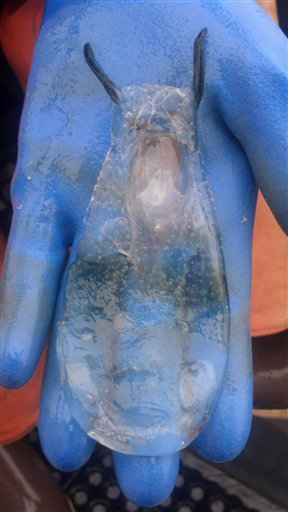
They look like a jellyfish, about the size of a human hand, with a hard head and a few tentacles. Scientists describe a salp as a pelagic tunicate which lives in the open ocean and has a tubelike body that pumps water for locomotion and to filter the plankton on which it feeds. Despite its translucent appearance, it is not closely related to jellyfish. It's a chordate, which means it has a spinal cord and is related to vertebrates. Salps can swim alone or in rope-like colonies. They have the ability to reproduce rapidly and can bloom when the plankton supply is rich. Marine scientists disagree as to whether their appearance is a sign of climate change in the sea.
Boats Wanted – DISCARDS AND SELECTIVITY
The State fisheries board, Bord Iascaigh Mhara, is going to carry out trials aimed at minimising discarding of fish and improving the use of fishing gear to avoid by-catches. Fishing vessel owners who would like to offer their vessels for use in the trials, as well as fishing gear and chandlery suppliers, are being invited to contact BIM, Crofton Road, Dun Laoghaire, Co. Dublin - Phone 01 2144100 Email:[email protected]
Oh No! – NO WAY TO PARK
Noisy parkers are a problem ashore, but if you have ever had trouble entering a marina, this video should be interesting.
Email: [email protected]
Regular news on Twitter: @Afloatmagazine @TomMacSweeney
Irish Coast Guard Collaborates On New Marine Monitoring System
#Coastguard - The Irish Coast Guard is collaborating on a new system of marine monitoring in the hopes of detecting a dead ship that may threaten to run aground on Ireland's shores.
The Newfoundland Shipping News blog details how the MV Lyubov Orlova, adrift somewhere in the North Atlantic, is being used to test the capabilities of a new system called Global Maritime Awareness.
The system is based on the idea that if the world's top satellite tracking technologies could be banded together, it could establish a much more comprehensive monitoring system for the marine environment.
Marine surveillance expert Guy Thomas, who devised the concept, said he had the idea that if a receiver akin to that used in the Automatic Identification System (AIS) for ship tracking and collision avoidance was put on a satellite in orbit, "you would now have the international identification system for ships that was lacking".
That was done, and a second accompanying system was added that provides radar information from space. The Global Maritime Awareness system combines those with detailed satellite imagery, and Long Range Identification and Tracking {LRIT) technology whereby ships can verify themselves to others and the systems tracking them.
Thomas says these four satellite systems working in tandem make for "a very effective tool in monitoring marine environments for illegal activity".
But it can also be used to prevent potential environmental catastrophes - which is where the MV Lyubov Orlova comes in.
The Irish Coast Guard's director Chris Reynolds contacted Thomas with its concerns that the dead ship might drift into Irish waters and become a burden on the State. Thomas suggested using his system to find it, almost like an ocean-wide version of the game Battleships: even when a ship isn't sending any signals, it can still be tracked, just by looking for ships that aren't transcending through AIS.
Thomas and the Irish Coast Guard are currently working hard at this, crossing off vessels that are communicating through satellite systems till they can narrow it down to the one they're looking for. And they may now have a hit south-southeast of Greenland, although it will be some days before they can confirm.
Newfoundland Shipping News has much more on the story HERE.
Fisherman Dies Of Head Injuries Off Kinsale
#Coastguard - The Irish Times reports that a fisherman has died after sustaining head injuries in an incident off the Old Head of Kinsale last night.
The man, one of three crew on the West Cork-based fishing trawler Liberty, is believed to have died from his injuries on board the vessel.
According to TheJournal.ie, the Courtmacsherry RNLI lifeboat and Irish Coast Guard helicopters from Shannon (Rescue 115) and Waterford (Rescue 117) were all scrambled to the scene.
The deceased was airlifted by Rescue 117 to Cork for transfer to hospital, while the remaining crew returned to Kinsale this morning with the lifeboat crew.
It is thought that the accident involved trawling wires on board the fishing boat.
Search for Missing Spanish Fisherman Off Southwest
#Coastguard - The Irish Coast Guard's Rescue 115 helicopter was tasked overnight to search for a missing Spanish fisherman who fell overboard from his fishing trawler off the southwest coast in the early hours of this morning.
98FM is reporting the latest news on this incident, saying that the man went into the sea some 25 miles off Mizen Head.
The alarm was raised around 4am and the coastguard station at Valentia is co-ordinating the search and rescue effort, with RNLI lifeboats from Baltimore and Castletownbere in West Cork assisting.
Belfast Coastguard Manager Resigns As Station Takes On Extra Load
#Coastguard - For Argyll in Scotland reports that Richard Newell has resigned from his post as rescue co-ordination centre manager at Belfast Coastguard.
The news comes some weeks after the command base took on extra responsibility with the permanent closure of the Clyde coastguard station last month.
Britain's Maritime and Coastguard Agency (MCA) confirmed to the website that Newell resigned from his position around two weeks ago - and that he has assured the agency that his decision has no connection with the streamlining plans being undertaken across Britain's coastguard network.
However, For Argyll alleges Newell had made it known locally that "if he considered the future [of the coastguard service] was becoming dangerous, then he would go".
As previously reported on Afloat.ie, campaigners for the Clyde coastguard station in western Scotland were taken aback by the early transfer of helicopter dispatches to Belfast and Stornoway in November, ahead of the base's permanent closure on 18 December last.
More than 30 jobs were lost with the scrapping of the Clyde control centre at Greenock, with much of its role now being taken up by the Belfast command centre at Bangor across the North Channel - a change to the original plan for Scottish stations to share the load till 2015.
Lifeboat Rescues Windsurfer In Stormy Conditions
#RNLI - Kilkeel RNLI rescued a windsurfer who got into difficulty in Carlingford, Co Louth yesterday (Tuesday 29 January).
The charity’s volunteer lifeboat crew was requested to launch by the Irish Coast Guard shortly after 2pm following a report that a windsurfer had got into difficulty in Carlingford Lough.
Launching their inshore lifeboat immediately, the crew encountered very unfavourable weather, with strong westerly winds of between force six and seven.
The lifeboat proceeded up the lough where they found and retrieved the windsurfer who had stayed by his board. The crew then attempted to retrieve the sail and board but couldn’t due to the windy weather conditions. They instead proceeded to tow the board into Greenore where the local coastguard took over.
Despite being in the water for approximately an hour, the casualty was described as being in reasonably good health.
Roy Teggarty, Kilkeel RNLI lifeboat operations manager, paid tribute to the lifeboat crew for their efforts in what was a challenging rescue:
"This was a day with difficult conditions because of the strong winds," he said. "It was mainly difficult to keep the lifeboat steady when retrieving the casualty so this rescue involved expert boat handling by all involved."
Coastguard Helicopter In Double Rescue On Sunday
#Coastguard - The Irish Coast Guard's Waterford-based rescue helicopter recovered two casualties in separate incidents on Sunday, according to the Irish Examiner.
One fisherman was retrieved from the French fishing vessel Larche some 50 nautical miles south of Cork after complaining of chest pains and difficulty breathing.
The man was winched on board coastguard helicopter Rescue 117 and transferred to hospital in Cork for treatment.
In a separate incident, a hillwalker was airlifted from Slievenamon in Tipperary after suffering leg injuries in a fall - the second such accident in the area over the weekend.



























